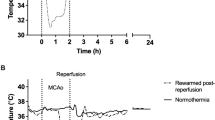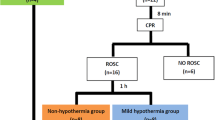Abstract
Using vascular heat-exchange controller implemented mild hypothermia treatment, the authors established the cerebral vasospasm model in which blood was injected twice into dog’s foramen magnum; and it was discussed the influence of the concentration of endothelin-1 and NO in blood plasma and cerebrospinal fluid through continuing treatment of mild hypothermia at different times in secondary brain vasospasm model after subarachnoid hemorrhage. Thirty healthy mongrel dogs were randomly divided into five groups; artificial cerebrospinal fluid group (group A), normal temperature control group (group C), mild hypothermia 8 h group (group H1), mild hypothermia 16 h group (group H2), and mild hypothermia 32 h group (group H3). The authors injected the artificial CSF into dog’s foramen magnum in group A while the other four groups were injected with autologous arterial blood. The normal group’s temperature maintained 38.5°C. The authors set the temperature at 33.5°C in mild hypothermia groups and this was maintained for 8, 16, and 32 h, respectively. ET-1 and NO levels in the cerebrospinal fluid and plasma were assayed in each group on days 0, 7, 14, and 21. Then the changes of the diameter of blood vessels of cerebral basilar artery and overall performance categories score in each group through application of CT angiography were recorded. In the cerebral vasospasm model which was constructed by injecting the blood to dog twice, mild hypothermia treatment, through the application of vascular heat-exchange controller, could reduce cerebral vasospasm. It was observed that the duration of the mild hypothermia is directly proportional to the longer duration of the relieving of cerebral vasospasm. The reciprocal changes observed in the levels of ET-1 and NO in cerebrospinal fluid and plasma revealed that it might be possible to reduce the cerebral vasospasm by regulating the rising amplitude of ET-1 and the decrease in NO in CSF and plasma.






Similar content being viewed by others
References
Mayberg, M. R. (1998). Cerebral vasospasm. Neurosurgery Clinics of North America, 9, 615–627.
Levati, A., Solaini, C., & Boselli, L. (1998). Prevention and treatment of vasospasm. Journal of Neurosurgical Sciences, 42, 27–31.
Kastner, S., Oertel, M. F., Scharbrodt, W., Krause, M., Boker, D. K., et al. (2005). Endothelin-1 in plasma, cisternal CSF and microdialysate following aneurysmal SAH. Acta Neurochir (Wien), 147, 1271–1279. discussion 1279.
Bernard, S. A., Jones, B. M., & Horne, M. K. (1997). Clinical trial of induced hypothermia in comatose survivors of out-of-hospital cardiac arrest. Annals of Emergency Medicine, 30, 146–153.
Yanagawa, Y., Ishihara, S., Norio, H., Takino, M., Kawakami, M., et al. (1998). Preliminary clinical outcome study of mild resuscitative hypothermia after out-of-hospital cardiopulmonary arrest. Resuscitation, 39, 61–66.
Zeiner, A., Holzer, M., Sterz, F., Behringer, W., Schorkhuber, W., et al. (2000). Mild resuscitative hypothermia to improve neurological outcome after cardiac arrest. A clinical feasibility trial. Hypothermia After Cardiac Arrest (HACA) Study Group. Stroke, 31, 86–94.
Marion, D. W., Penrod, L. E., Kelsey, S. F., Obrist, W. D., Kochanek, P. M., et al. (1997). Treatment of traumatic brain injury with moderate hypothermia. New England Journal of Medicine, 336, 540–546.
Popovic, R., Liniger, R., & Bickler, P. E. (2000). Anesthetics and mild hypothermia similarly prevent hippocampal neuron death in an in vitro model of cerebral ischemia. Anesthesiology, 92, 1343–1349.
Doufas, A. G., Akca, O., Barry, A., Petrusca, D. A., Suleman, M. I., et al. (2002). Initial experience with a novel heat-exchanging catheter in neurosurgical patients. Anesthesia and Analgesia, 95, 1752–1756. table of contents.
Steinberg, G. K., Ogilvy, C. S., Shuer, L. M., Connolly, E. S, Jr., Solomon, R. A., et al. (2004). Comparison of endovascular and surface cooling during unruptured cerebral aneurysm repair. Neurosurgery, 55, 307–314. discussion 314–305.
Mascia, L., Fedorko, L., Stewart, D. J., Mohamed, F., terBrugge, K., et al. (2001). Temporal relationship between endothelin-1 concentrations and cerebral vasospasm in patients with aneurysmal subarachnoid hemorrhage. Stroke, 32, 1185–1190.
Liu, Z., Zheng, J. F., Yang, L. Q., Yi, L., & Hu, B. (2007). Effects of sinomenine on NO/nNOS system in cerebellum and spinal cord of morphine-dependent and withdrawal mice. Sheng Li Xue Bao, 59, 285–292.
Drury, P. P., Bennet, L., & Gunn, A. J. (2010). Mechanisms of hypothermic neuroprotection. Seminars in Fetal and Neonatal Medicine, 15, 287–292.
Pool, J. L., & Kessler, L. A. (1958). Mechanism and control of centrally induced cardiac irregularities during hypothermia. I. Clinical observations. Journal of Neurosurgery, 15, 52–64.
Webb, W. R., Deguzman, V. C., Grogan, J. B., & Artz, C. P. (1962). Hypothermia: Its effects upon hematologic clearance in experimentally induced staphylococcal bacteremia. Surgery, 52, 643–647.
Busto, R., Dietrich, W. D., Globus, M. Y., Valdes, I., Scheinberg, P., et al. (1987). Small differences in intraischemic brain temperature critically determine the extent of ischemic neuronal injury. Journal of Cerebral Blood Flow and Metabolism, 7, 729–738.
Hoedemaekers, C. W., Ezzahti, M., Gerritsen, A., & van der Hoeven, J. G. (2007). Comparison of cooling methods to induce and maintain normo- and hypothermia in intensive care unit patients: a prospective intervention study. Critical Care, 11, R91.
Al-Senani, F. M., Graffagnino, C., Grotta, J. C., Saiki, R., Wood, D., et al. (2004). A prospective, multicenter pilot study to evaluate the feasibility and safety of using the CoolGard System and Icy catheter following cardiac arrest. Resuscitation, 62, 143–150.
Kandzari, D. E., Chu, A., Brodie, B. R., Stuckey, T. A., Hermiller, J. B., et al. (2004). Feasibility of endovascular cooling as an adjunct to primary percutaneous coronary intervention (results of the LOWTEMP pilot study). American Journal of Cardiology, 93, 636–639.
Koide, M., Nishizawa, S., Ohta, S., Yokoyama, T., & Namba, H. (2002). Chronological changes of the contractile mechanism in prolonged vasospasm after subarachnoid hemorrhage: from protein kinase C to protein tyrosine kinase. Neurosurgery, 51, 1468–1474. discussion 1474–1466.
Nishizawa, S., Obara, K., Koide, M., Nakayama, K., Ohta, S., et al. (2003). Attenuation of canine cerebral vasospasm after subarachnoid hemorrhage by protein kinase C inhibitors despite augmented phosphorylation of myosin light chain. Journal of Vascular Research, 40, 169–178.
Leung, J. W., Chung, S. S., & Chung, S. K. (2009). Endothelial endothelin-1 over-expression using receptor tyrosine kinase tie-1 promoter leads to more severe vascular permeability and blood brain barrier breakdown after transient middle cerebral artery occlusion. Brain Research, 1266, 121–129.
Didier, N., Romero, I. A., Creminon, C., Wijkhuisen, A., Grassi, J., et al. (2003). Secretion of interleukin-1beta by astrocytes mediates endothelin-1 and tumour necrosis factor-alpha effects on human brain microvascular endothelial cell permeability. Journal of Neurochemistry, 86, 246–254.
Petrov, T., Steiner, J., Braun, B., & Rafols, J. A. (2002). Sources of endothelin-1 in hippocampus and cortex following traumatic brain injury. Neuroscience, 115, 275–283.
Ohlstein, E. H., & Storer, B. L. (1992). Oxyhemoglobin stimulation of endothelin production in cultured endothelial cells. Journal of Neurosurgery, 77, 274–278.
Juvela, S. (2000). Plasma endothelin concentrations after aneurysmal subarachnoid hemorrhage. Journal of Neurosurgery, 92, 390–400.
Seifert, V., Loffler, B. M., Zimmermann, M., Roux, S., & Stolke, D. (1995). Endothelin concentrations in patients with aneurysmal subarachnoid hemorrhage. Correlation with cerebral vasospasm, delayed ischemic neurological deficits, and volume of hematoma. Journal of Neurosurgery, 82, 55–62.
Mizuno, Y., Isotani, E., Ohno, K., Nagai, A., Imamura, M., et al. (2008). Involvement of accumulated NOS inhibitors and endothelin-1, enhanced arginase, and impaired DDAH activities in pulmonary dysfunction following subarachnoid hemorrhage in the rabbit. Vascular Pharmacology, 48, 21–31.
Nishizawa, S., Chen, D., Yokoyama, T., Yokota, N., & Otha, S. (2000). Endothelin-1 initiates the development of vasospasm after subarachnoid haemorrhage through protein kinase C activation, but does not contribute to prolonged vasospasm. Acta Neurochirurgica (Wien), 142, 1409–1415.
Alabadi, J. A., Torregrosa, G., Miranda, F. J., Salom, J. B., Centeno, J. M., et al. (1997). Impairment of the modulatory role of nitric oxide on the endothelin-1-elicited contraction of cerebral arteries: A pathogenetic factor in cerebral vasospasm after subarachnoid hemorrhage? Neurosurgery, 41, 245–252. discussion 252–243.
Neuschmelting, V., Marbacher, S., Fathi, A. R., Jakob, S. M., & Fandino, J. (2009). Elevated level of endothelin-1 in cerebrospinal fluid and lack of nitric oxide in basilar arterial plasma associated with cerebral vasospasm after subarachnoid haemorrhage in rabbits. Acta Neurochirurgica (Wien), 151, 795–801. discussion 801-792.
Jung, C. S., Oldfield, E. H., Harvey-White, J., Espey, M. G., Zimmermann, M., et al. (2007). Association of an endogenous inhibitor of nitric oxide synthase with cerebral vasospasm in patients with aneurysmal subarachnoid hemorrhage. Journal of Neurosurgery, 107, 945–950.
Author information
Authors and Affiliations
Corresponding author
Rights and permissions
About this article
Cite this article
Wang, Zp., Chen, Hs. & Wang, FX. Influence of Plasma and Cerebrospinal Fluid Levels of Endothelin-1 and No in Reducing Cerebral Vasospasm after Subarachnoid Hemorrhage During Treatment with Mild Hypothermia, in a Dog Model. Cell Biochem Biophys 61, 137–143 (2011). https://doi.org/10.1007/s12013-011-9170-z
Published:
Issue Date:
DOI: https://doi.org/10.1007/s12013-011-9170-z




